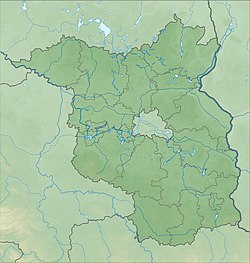You can help expand this article with text translated from the corresponding article in German. (September 2011)Click [show] for important translation instructions.
|
| Alte Oder | |
|---|---|
 Alte Oder near Bad Freienwalde | |
| Location | |
| Country | Germany |
| State | Brandenburg |
| Physical characteristics | |
| Mouth | |
• location | Oder |
• coordinates | 52°52′51″N14°09′26″E / 52.8807°N 14.1571°E |
Alte Oder is a branch on the river Oder in Brandenburg, Germany. [1] It drains the Oderbruch basin, flowing northwards to the confluence with the Oder near Hohensaaten. It is one of several branches of the Oder named "Alte Oder". [1]
